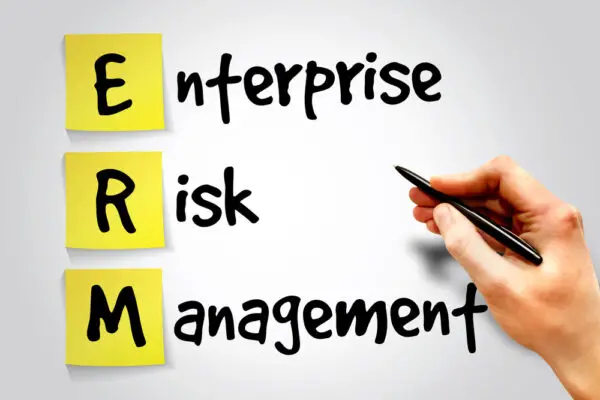In organizations, risk can be defined as the potential for events or actions to adversely affect the organization’s ability to achieve its objectives and execute its strategies successfully. Risk can arise from various sources, such as financial uncertainty, legal liabilities, strategic management errors, accidents, and natural disasters.
Organizational risk typically falls into several categories:
Strategic risk involves decisions affecting the company’s ability to achieve its goals. Examples include decisions about market positioning, mergers and acquisitions, and major investments.
Operational risk: This involves risks associated with the organization’s operational and administrative procedures, including everything from IT systems and physical infrastructure to human resources practices and supply chain management.
Financial risk: This involves risks related to financial transactions and the financial structure of the organization, such as currency exchange rates, interest rates, credit risks, liquidity risks, and investment risks
Compliance risk: This involves legal or regulatory sanctions, material financial loss, or loss to an organization’s reputation due to its failure to comply with laws, regulations, rules, related self-regulatory organization standards, and codes of conduct applicable to its activities.
In all cases, risk represents a degree of uncertainty about the outcomes of actions, decisions, or events, and it requires organizations to assess the likelihood of various outcomes and their potential impact on the organization’s goals and objectives.
Organizations usually manage risks through identification, assessment, control strategies, and ongoing monitoring.
Risk is an inherent part of the human experience, permeating every aspect of our lives. Despite its ubiquity, however, risk can be difficult to define and understand.
The ISO 31000:2018 standard provides guidelines for risk management in organizations. According to this standard, risk is defined as the “effect of uncertainty on objectives.” This definition emphasizes that risk is not just about negative events or outcomes but can also include positive opportunities.

How Does Risk Management Add Value To An Organisation
Effect: An effect is a deviation from the expected, something which can be positive, negative, or both, and can address, create, or result in opportunities and threats.
Uncertainty: Uncertainty is the state of deficiency of information related to understanding or knowledge of an event, its consequences, or likelihood.
Objectives: Objectives can have different aspects (such as financial, health and safety, and environmental goals) and can apply at different levels (such as strategic, organization-wide goal, project, product, and process).
ISO 31000 standard encourages a comprehensive approach to risk management encompassing the entire organization and emphasizes the importance of integrating risk management into all organizational processes, including decision-making. This includes identifying, assessing, managing, and communicating risk in various contexts.
Risk can be defined as the possibility of negative outcomes resulting from specific actions / armies or inactions. This can include physical risks such as injury, death or illness, financial risks such as loss of income or investments, legal risks such as lawsuits or criminal charges, and social risks such as damaged relationships or reputations.
Understanding the nature and scope of it is essential for making informed decisions and taking appropriate precautions to mitigate its impact on daily life.

RISK MANAGEMENT
Defining Risk
Risk is the probability or likelihood of an adverse event and its potential impact on people, assets, or the environment. The biggest risk often involves making strategic decisions that can lead to significant consequences, much like in the game of Risk where global conquest requires bold moves. It is a fundamental concept in risk management and analysis, enabling decision-makers to identify, assess, prioritize, and mitigate risks effectively.
It can be measured using various quantitative or qualitative methods based on data analysis and expert judgment.
Moreover, It can be classified according to its source (e.g., natural disasters vs. human-made accidents), severity (e.g., minor vs. catastrophic), frequency (e.g., rare vs. common), duration (e.g., short-term vs. long-term), and a number a other factors that affect its nature and magnitude.
Additionally, understanding the different dimensions of it is essential for developing appropriate strategies to manage it proactively rather than reactively.
Defining risk is crucial for any organization or individual who wants to anticipate potential threats or opportunities that might affect their objectives or interests.
Factors Contributing to Risk
Various variables and elements, including the actions of other players, may significantly impact the level of risk associated with a particular situation or event. These factors are commonly referred to as ‘risk factors‘ and can include internal and external elements contributing to the likelihood of an adverse outcome.
Examples of risk factors can be found in various domains, such as finance, health care, engineering, and environmental studies. To assess the potential risks involved in a given scenario, experts usually conduct a risk analysis to identify all relevant factors.
In financial contexts, common risk factors include market volatility, interest rate changes, economic downturns, political instability, fraud, or misconduct by employees or management personnel.
In healthcare settings, risk factors may involve patient demographics (e.g., age), medical history (e.g., pre-existing conditions), medication use (e.g., side effects), and clinical procedures (e.g., surgery).
Other types of risks could emerge from technological advances (e.g., cyber-attacks), natural disasters (e.g., floods), human error or negligence (e.g., accidents at work), regulatory changes (e.g., new laws affecting certain industries), and environmental hazards.
Risk analysis is essential for making informed decisions about complex situations that entail multiple uncertainties.
Risk analysis also helps stakeholders understand better how different variables interact with each other and how they affect the overall level of uncertainty associated with a particular project or plan.
Effective risk management requires ongoing monitoring and evaluation of all relevant inputs to ensure that any emerging risks are promptly addressed before they escalate into major problems.
Types of Risk
One type of risk that businesses face is financial risk, which refers to the possibility of losing money due to fluctuations in market conditions, credit default, or poor financial management. In the digital age, strategic risks such as global domination in competitive markets also pose significant challenges.
Financial risk can be divided into several categories, including market risk, credit risk, liquidity risk, and operational risk.
Market risks arise from changes in interest rates, exchange rates, and world commodity prices, while credit risks refer to the possibility of borrowers defaulting on their loans.
Another type of risk that businesses face is an environmental risk which refers to the potential harm caused by natural disasters such as floods, hurricanes, earthquakes, and wildfires. Environmental risks also include pollution and climate change which may cause damage to infrastructure or disrupt supply chains.
Businesses must proactively manage environmental risks by implementing disaster recovery plans and ensuring compliance with environmental regulations.
Financial risks arise from various sources, such as market volatility or poor financial management practices. Environmental risks are due to natural disasters or other factors that cause harm to the environment.
Managing Risk
Managing risk is an essential aspect of any business or organization and involves several key points, including risk assessment, risk mitigation, and risk transfer. Just as in the game Risk, where players aim for global conquest through strategic moves, businesses must also strategically manage risks to achieve their goals.
Risk assessment involves identifying potential risks and analyzing their likelihood and potential impact on the organization.
Risk mitigation strategies involve reducing the likelihood or impact of identified risks. In contrast, risk transfer involves shifting the responsibility for managing certain risks to another party through insurance or contractual agreements.
Risk Assessment
Evaluating potential hazards, identifying their likelihood and consequences, and determining the acceptable risk level are crucial to conducting a comprehensive risk assessment. Risk assessment techniques can be classified into two broad categories; quantitative and qualitative.
Quantitative risk assessment involves using mathematical models to evaluate risk levels by assigning numerical values to various parameters such as probability, severity, and frequency of occurrence.
On the other hand, qualitative risk assessment is based on subjective judgments about risks using expert knowledge or experience. This method evaluates risks based on factors such as severity, likelihood, and impact without assigning numerical values.
While both methods have their strengths and weaknesses, it is important to choose an appropriate approach depending on the nature of the hazard being evaluated.
An effective risk assessment should also consider uncertainties associated with data quality or limitations in modeling assumptions to ensure that all possible scenarios are adequately considered.
Risk Mitigation
One crucial aspect of reducing the probability and impact of potential hazards involves implementing proactive measures designed to prevent or minimize their occurrence.
This process is known as risk mitigation, which aims to identify, assess, and prioritize risks before taking necessary actions. Risk mitigation aims to reduce the likelihood and severity of negative events while balancing the cost-benefit analysis.
Cost-benefit analysis is essential to risk mitigation because it helps decision-makers justify investments in mitigating potential hazards. It involves weighing the costs of various mitigation strategies against their potential benefits.
A thorough cost-benefit analysis ensures that risk game resources are allocated effectively and efficiently, thereby minimizing the impact of risks on an organization’s operations.
Additionally, likelihood analysis is critical in determining which risks pose the greatest threat to an organization and a risk cards should be prioritized for mitigation efforts.
Risk Transfer and Insurance
In risk transfer, the player or organization shifts potential liabilities to a third party through contractual agreements or insurance policies, akin to commanders passing on responsibilities in a strategic battle.
Insurance coverage is one of the most common forms of risk transfer businesses use to manage their risks. Insurance companies provide liability protection for businesses against potential lawsuits related to their operations.
Insurance coverage can include general liability, professional liability, product liability, and cyber liability insurance policies. Insurance policies are designed to cover various types of risks an organization may face and help them manage their exposure to them over time.
In addition to insurance coverage, organizations can transfer risks through contractual agreements with vendors or suppliers who assume responsibility for specific aspects of the business process.
Risk transfer is an essential component of risk management that helps organizations protect their assets and minimize financial losses in case unforeseen events occur.
Avoidance
Risk avoidance involves eliminating the risk entirely, often by choosing not to engage in a certain activity. For example, an organization might decide not to enter a market with significant regulatory or political risks
Reduction
A risk reduction strategy involves reducing the risk’s likelihood or impact. For instance, an organization might implement new safety procedures to reduce the risk of workplace accidents or diversify its supply chain to reduce the risk of supply disruptions
Acceptance
Sometimes, after evaluating a risk, an organization may decide to accept it. This typically happens when the cost of mitigating the risk is higher than the potential loss or when the potential benefits outweigh the potential risks. In this case, the organization may create a contingency plan to deal with the potential consequences if the risk event occurs.
It’s worth noting that risk mitigation strategies should be chosen based on a thorough risk assessment. The chosen strategies should align with the organization’s risk tolerance and strategic objectives. The effectiveness of risk mitigation strategies should also be continually monitored and adjusted as needed.

managing risks
Impact of Risk on Daily Life and Life Decisions
Risk is inherent in these spheres of play and can have significant consequences for individuals and organizations. Just like in the game of Risk, where players have a secret mission to complete, personal and professional decisions often involve hidden objectives that can influence outcomes.
Understanding how risk affects our daily lives is crucial for making informed decisions and managing potential pitfalls.
Personal Decision Making
Making decisions involving potential consequences necessitates a thorough evaluation of the available information to minimize negative outcomes.
Various factors, including ethical considerations and cognitive biases, can influence personal decision-making.
Ethical considerations refer to the principles and values that guide individuals’ actions, while cognitive biases are mental shortcuts or heuristics that can lead to errors in judgment.
For instance, deciding whether to report a colleague’s wrongdoing could involve balancing loyalty to the colleague with honesty and integrity. In such cases, individuals need to consider the potential consequences of their actions on themselves, others involved, and society as a whole.
Additionally, cognitive biases such as confirmation bias or framing effects can affect how individuals perceive and evaluate information when making decisions.
Professional Decision Making
Ethical considerations are at the forefront of this process, as decisions made in a professional setting can have significant consequences for individuals and organizations.
Professionals must consider ethical principles such as fairness, honesty, and respect for others when making decisions that impact stakeholders.
However, cognitive biases can interfere with objectively analyzing the situation and lead to flawed decision-making processes. Cognitive biases refer to mental shortcuts or errors in reasoning that arise due to subjective interpretation of information. These biases can affect how professionals perceive risks, evaluate evidence, and judge potential outcomes.
To mitigate these biases, professionals should think critically and seek out diverse perspectives before making any significant decision.
Multinational Corporations
Multinational corporations, which operate in multiple countries & territories and often have global reach, present unique professional challenges when making ethical decisions.
The globalization impact on these corporations is immense, especially since they must navigate different legal frameworks and cultural differences across various nations.
This can create confusion about acceptable business practices in each country / territory where the corporation operates. Professionals must be aware of and sensitive to these differences when making decisions.
Cultural differences can significantly affect multinational corporations’ decision-making processes. For example, a company may have an established policy of offering gifts or bribes to government officials in certain countries to secure business deals.
However, such practices could be illegal or unethical in other countries where the company operates. Professionals must carefully consider their actions and weigh them against the cultural norms of each country where they live or conduct business.
Frequently Asked Questions
What is the difference between risk and uncertainty?
Risk refers to situations where the probability of an event occurring can be quantified or estimated objectively.
In contrast, uncertainty refers to situations where it is impossible or difficult to assign probabilities due to ambiguity in information or lack of knowledge.
Probability vs. ambiguity is a central theme in distinguishing between risk and uncertainty, as probability requires objective data, whereas ambiguity involves subjective interpretation.
Objective vs. subjective also plays a role as rely on objective data, while uncertainty involves more subjective judgment calls.
How do personal biases affect risk perception?
Confirmation bias, for instance, is the tendency to seek information confirming pre-existing beliefs while ignoring evidence to the contrary. Confirmation bias can al turn lead individuals to overlook potential risks or downplay their significance.
Similarly, the availability heuristic games, the game where people rely on easily accessible examples when making decisions, can skew their perception of risk. For example, if someone knows someone who has experienced a negative outcome from a particular activity or situation, they may perceive the risk as higher than it is.
What are some common misconceptions about risk?
One of the most common misconceptions is that all risks are equal. This is not true; some risks are more severe than others and require different mitigation strategies.
Another myth is that avoiding risk altogether is always the best option, but this can lead to missed opportunities for growth or reward.
Additionally, people often underestimate their own ability to manage risks effectively, leading them to either take on too much risk or avoid it altogether.
How do cultural and societal factors impact risk assessment?
Cultural and societal factors are essential in how individuals perceive and evaluate risks
For instance, cultural norms significantly influence the level of risk tolerance within a community. A society that values individualism may be more willing to take on personal risks, while one with greater emphasis on collective welfare may prioritize avoiding potential harm altogether.
Can risk ever be eliminated, or is it always present in some form?
Risk is an inherent aspect of any activity and cannot be entirely eliminated. However, risk management strategies can help mitigate potential threats and minimize their impact on individuals or organizations.
The role of technology in risk reduction has been crucial in recent years, with various technological advancements enabling us to identify and respond to risks more effectively.
For instance, predictive analytics tools can help predict future risks by analyzing patterns and trends from historical data.
Moreover, technologies such as artificial intelligence (AI) and machine learning offer real-time insights into potential vulnerabilities in a system or process that can be monitored continuously.

Enterprise Risk Management Key Risk Indicators
Risk is a concept that has been present in human society since the beginning of time. It refers to the possibility of harm or loss due to a particular action or event. Defining risk is essential as it helps us understand the potential consequences of our decisions and actions.
Risk can be influenced by various factors, including environmental, social, economic, and personal factors. There are different types of risks that people encounter in their daily lives, such as financial risks, health risks, safety risks, and emotional risks.
Managing these risks requires taking proactive measures to mitigate their impact once the world. This can involve taking insurance policies or adopting preventative health measures.

Chris Ekai is a Risk Management expert with over 10 years of experience in the field. He has a Master’s(MSc) degree in Risk Management from University of Portsmouth and is a CPA and Finance professional. He currently works as a Content Manager at Risk Publishing, writing about Enterprise Risk Management, Business Continuity Management and Project Management.


